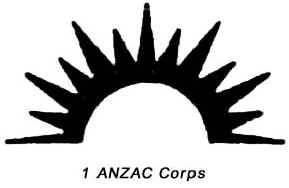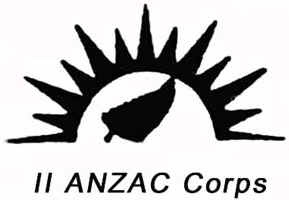 |
| Category:1st AIF |

|
|
|
|
|
 |

|
- In February 1916 when I Anzac Corps moved from
Egypt to France it consisted of
- 1st Australian Division
- 2nd Australian Division
- The New Zealand Division
|
- In May 1916 when II Anzac Corps moved from Egypt to
France it consisted of
- 4th Australian Division
- 5th Australian Division
- At
Messines in 1917
II Anzac Corps was made up of
- a British Division
- the New Zealand Division
- 3rd Australian Division
- 4th Australian Division
|
-
Later 1 Anzac
and 2 Anzac were combined, without the New Zealanders, and became
the Australian Corps. With the addition of some Americans it became
the largest Corps in the British Army with some 200,000 men under
arms. Monash used it to smash the Hindenburg Line and bring the war
to a conclusion.
|
| Notes. In
1916 The British Expeditionary Force consisted of 49 Divisions
(including the 5 Aussie Divisions) and the French had 111 Divisions
(some as low quality reserves). The British Empire had 1,263,000 men
in France including 90,000 Australians. |
| What is a Corps?
The main role of a Lieutenant
General was command of a Corps. This was a huge formation; the
Australian Corps in France was normally fielding around 200,000 men in
1918. Corps became more important as the war went on. In 1914, Corps
were just a grouping of divisions, and their only permanent units were a
Headquarters and a Signal company.
By 1918, so-called corps troops (those
troops allocated to the Corps but not one of its divisions) numbered
over 50,000. Corps was the the major tactical and operational formation,
but had no input into strategic matters. Under British doctrine, Corps
was responsible for the administration of the area in which it operated,
but its logistical "tail" remained smaller than its fighting
"teeth" -- something by no means true of Army, the next
formation up.
In addition to the commander, the Corps
Headquarters also had posts for five Brigadier Generals, for a chief of
staff (BGGS), engineers, administration, artillery (GOCRA) and heavy
artillery (BGHA). |
-
The Australian Corps was the largest
and most powerful military force in this nation's history. It consisted
of 4 Australian Divisions and support troops. (Approx 170,000 men)
-
It was a combination of 1 Anzac Corps
& II Anzac Corps minus the New Zealanders
When you consider the AIF
you must remember that it was never designed to be, and never became, a
completely self sufficient Army. From the word "Go" it was designed to
provide combat troops and some limited support for them but that it would become part
of a larger (British) army that would provide the essential support
services.
-
Webmaster's note. It
will be clearly seen that the British Units, shown below in black
italic still made up a large
section of the "non-front line" troops
-
Note also the US troops
in the Corps.
Australian Corps (France, 6 July 1918)
-
3rd Flying Squadron [12
x RE8 reconnaissance aircraft]
-
British 13th, 16th Captive Balloon
Sections [4 Kite Balloons]
-
British F, G, H Anti-Aircraft
Batteries [12 x 13 pounder Anti-aircraft
Guns]
-
Australian Corps
Engineers
-
Australian Corps
Troops Engineers
-
1st Army Troops
Company
-
British 146th, 238th, 283rd,
567th Army Troops Companies
-
1st,2nd
Tunnelling Companies (New South Wales; Victoria and South
Australia; all states)
-
British 170th, 182nd, 254th
Tunnelling Companies
-
United States
A, C, E, F Companies, 6th Engineer Regiment
-
British 5th Field Survey
Company
-
British 11th Pontoon Park
-
Australian Corps
Signals Company
-
Australian Corps
Topographical Section
-
Australian Corps
Workshops
-
British E, H Special Projector
Companies
-
British 353rd Electrical Company
-
British 3rd Boring Section
-
British
6th,7th,16th,17th,29th,50th Searchlight Companies
-
British 47th, 63rd, 67th Labour
Group Headquarters
-
British 1st, 14th, 15th,
21st, 49th, 47th, 74th, 83rd, 85th, 86th, 90th, 105th, 114,
168th, 173rd, 193rd, 714th Labour Companies
-
2nd,3rd,4th,5th
Divisions
-
British 3rd Motor Ambulance Convoy
-
98th, 99th Dental Units
-
13th Light Horse
Regiment (Victoria)
-
1st Cyclist Battalion
-
British 10th(Medium), 17th (Light),
47th (Light) Ordnance Mobile Workshops
-
Australian Corps
Salvage Section
-
Australian Corps
Mechanical Transport Column
-
1st,2nd,3rd,4th,5th,6th
Mechanical Transport Companies
-
British 4th Auxiliary Horse
Transport Company
-
British 77th Sanitary Section
-
1st Employment Company
Most text by
Ross Mallett |
|